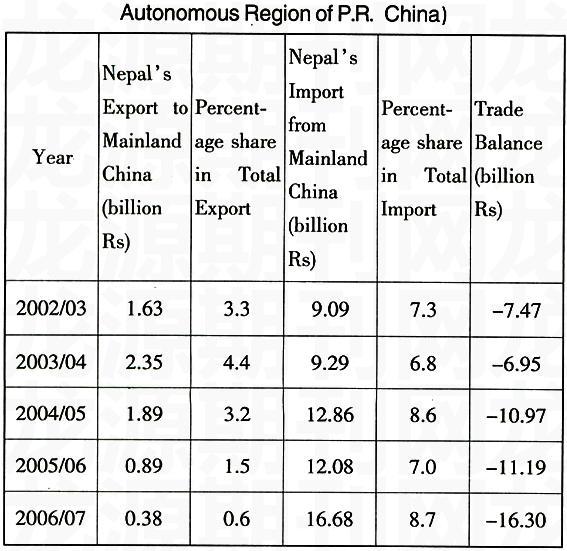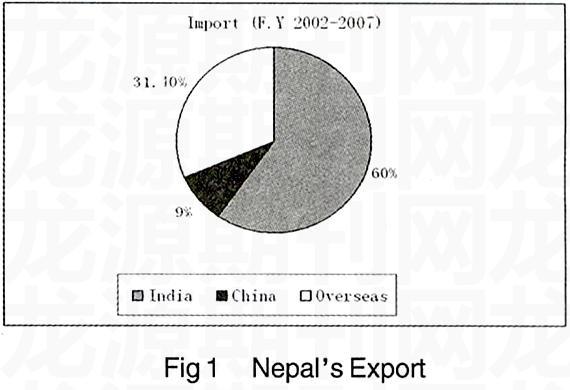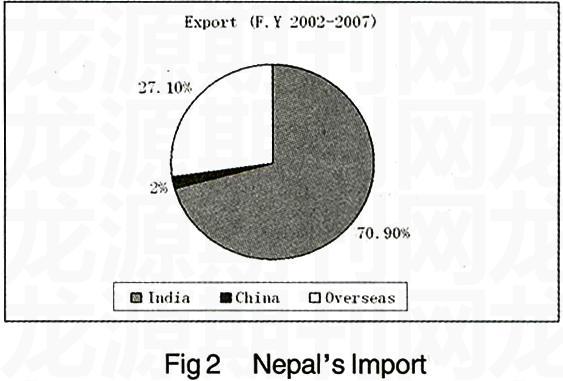Study on Nepal-China Economic Relations
2009-12-25AsmitaPokhrelUNYing
Asmita Pokhrel UN Ying



Abstract: The Chinese economy is in the process of gradual transformation towards a market economy and opening to the outside world. Nepal is also committed to promoting private sector-led economic growth based on liberalization and deregulated competitive markets. To this effect the country has already introduced a range of policy reforms related to exchanged rate policy, trade and industrial policy, foreign investment policy and privatization. Both countries are now the member of the World Trade Organization. These changes in economic policies of the two neighbors have created favorable.
Key words: World Trade Organization; Comparative Advantage; Imports; Exports; Economic Cooperation
doi : 10 . 3969 / j . issn . 1673 - 0194 . 2009 . 21 . 029
CLC number:F830Article character:AActicle ID:1673 - 0194(2009)21 - 0092 - 04
1Nepal - China Trade
Nepal and china have a long history of trade relations dating back to centuries. Traders from both sides have been engaged in border trade exchanging goods, which met their respective needs since the time immemorial. The difficult terrain and harsh climate made it virtually impossible to produce food and other necessary edibles in Tibet and transportation of these items from mainland china was not economically and physically viable because of inaccessible plateau. Nepalese traders continued to supply food and basic necessities to the Tibetan people in exchange for gold, wool, salt, sheep, and herbs. When Tibet became an Autonomous Region of China, the demand for essential goods increased significantly due to presence of Chinese and dislocation of trade there. In the course of trade some Nepalese traders had established not only their shops but also their homes in Lhasa and also married to Tibetan girls. This reinforced the traditional trade links adding a new dimension in terms of matrimonialrelations. Kerung, Kuti, Mustang, and Olanchunggola served as the main trade routes between Nepal and Tibet and also between Tibet and India via Nepal. The desire to both countries to maintain traditional relation and trade intercourse was also reflected in the Nepal-china Agreement of September 20, 1956, which stated,“the inhabitants of the border districts of the two countries who cross the border to carryout petty trade, to visit friends or relatives, or for seasonal changes of residence may do so as they have done customarily and need not hold passports, visas or other documents of certification." After the Sino-Indian war in 1962 border trade became even more important because the closure of Yamrang and Borang towns bordering India which were reopened only in 1992. However trade between Tibet Autonomous Region of China and Nepal did not get significant boost until the construction of 104-km long kathmandu-kodari highway in 1967.
2Volume and Composition of Trade
Table 1 Nepals Trade with P.R.China (Including Tibet Autonomous Region of P.R.China)
Source: Research and Information Division of FNCCI from Trade and Export Promotion Center.
Composition of Trade
Exports: Nepals export to mainland china consists of a handful of commodities. Handicrafts, button, and Nepali paper and paper products recorded highly export, but in recent years wooden and bamboo goods and personal goods recorded the highest export.
Imports: Nepals Import from mainland china includes Electric goods, Transport Equipment, Machinery & parts, Construction Materials, Shoes&Sandals, Textiles, video, television, readymade garments etc.
3Prospects of Expanding Nepal-China Trade
Nepal and China, as close and friendly neighbors, have great potentialities in further developing economic cooperation which has not yet been fully tapped.
As China is an emerging economic power in the world while Nepal is endowed with rich and untapped natural resources, the combination of Chinese capital and technology with Nepals abounding resources will benefit enormously to both countries.
Agro-based and forest based industries, hydropower, tourism, medicinal herbs and pharmaceutical, construction material, transportation, banking and financial institutions are among the important areas where Nepal offer best opportunities for investment.
The potentiality of expanding Nepal-China trade is immense. We can change Nepal into land-linked country from the status of landlocked country. In addition, there are huge potentialities for developing Nepali route to trade between Bangladesh and Pakistan, and China. But, we need to seriously initiate efforts to cash in the growing Chinese economies. For this, infrastructure development programs, mainly road and train networks must get a high priority. China is extending its railway network to Shighatse from Lhasa, and Nepal should take efforts to link it up to the border point. Four-lane highways from north to south must be built. The reforms in customs terminals and border points are also necessary.
Nepal would be requiring increasingly large number of machinery, transport equipment, consumer durables and a variety of consumer goods from china for facilitating the countrys development drive and meeting the requirements of growing population. The opening up and increasing efficiency of Chinese economy and the import liberalization process initiated in Nepal will make Chinese products highly competitive in Nepal.
There are high possibility to attract Chinese investments on hydropower, education and other agro-based industries. Chinese investors are interested and willing to run businesses in Nepal. We can set up education and hydropower zones with Chinese investments. To materialize it, we need to create political stability and consensus. High-level Chinese delegations have been visiting Nepal in the recent times to explore business opportunities here.
Nepal has to chalk out comparative advantage strategy in order to benefit economically from either exporting our products to China, attracting Chinese investment and tourists to Nepal or both. Clearly, concrete action is required in the coming days, on the part of our government to best reap the economic benefit from our northern neighbor, China. Concomitantly, the privet sector too, needs serious contemplation on how it intends to business with China. By crystallizing all efforts in this area, perhaps, the nation as a whole, could take advantage from the immense potential that exist today before us.
Primarily, in the fields of tourism, trade, transportation, cultural exchange and water resources Nepal and China could work together and derive benefits immensely making our relationship more meaningful, result oriented and mutually beneficial. China as our close and trusted friend can be of great assistance in the process of our national reconstruction at this crucial juncture of great transition.
4Impact of Becoming a Transit Point Between India and China
King Gyanendra declared that Nepal could be a transit point for trade between India and China in 2005. Nepal needs to make a long-term strategy to benefit by developing as an entrecote between India and China. As the size of market in Tibet is too small for consumer goods from India, it is possible that supply of construction materials to Tibet from India would be attractive as such material supplied from eastern part of China would be much more expensive compared to that which could be supplied from India. This is in view of great emphasis that is being given in China to develop its western part in Tibet and Xinkiang. Some trade routes between India and China are in such areas as Arunachal Pradesh and Ladakh where the boundary dispute between the two countries has not yet been resolved and which led to a limited war between the two countries. Although there are other alternate routes such as through Nathu-La pass in Sikkim and Stilwel Road, the existingKathmandu-Kodari Road and the proposed Kathmandu-Rasuwa Road are attractive options for using in Sino-Indian trade. However, Nepal would need to ensure that the roads connecting India and China via Nepal such as Kodari Road are improved so that it could be used for containerized cargo and making relevant regulations that will facilitate such trade. On the other hand, progress is being made in the construction of road to Rasuwa situated northwest of Kathmandu, which will link Keyrung in Tibet. Communications, Planning, Survey and Design Institute of TAR is reported to have completed survey and soil investigation and similar work is being undertaken by Nepal after which final design of entire road will be completed. There is already a road from Kathmandu to Syabrubensi in Rasuwa District. It is necessary to construct only 18 km inside Nepalese territory to reach the Chinese border. Rasuwa-Keyrong sector of the road is 30 km. This road will also shorten the distance from the Terai to the Chinese border from 389 km in Kodari Highway to 304 km. There have been reports of increased economic activity along thealignment of proposed road recently as the Customs office in Syabrubesi reported a revenue of Rs 3 million in 2004-5 compared to Rs 500,000 in 2003-4. Actually, the road via Rasuwa to Keyrong can be used throughout the year and is the shortest route. As railways constitute a mode of surface transport that is relatively cheap, the possibility of connecting Chinese Railway in Tibet to the Indian Railways via Nepal should be studied.
5Conclusion
China and Nepal are close neighbors and true friends who trust each other. The bilateral relations between the two countries may be described as excellent and problem-free since time immemorial and such exchange of visits at the high level will help to enhance friendship and cooperation in all fields. Both at the official and the peoples level the friendly ties between two neighboring countries are strong and cordial. Hence both the countries have carried out fruitful cooperation in many wide areas.
China being a developing country, its foreign policy has always been directed towards the peace and prosperity of the Third World. She has made rapid progress in the field of economic development in the past two decades especially since she adopted an open door and reform policy in 1978. Thus China is emerging as one of the global economic powers due to her tremendous economic and industrial development. Especially in the poverty eradication campaign China has achieved unprecedented success. Economic development and poverty alleviation have stood as our prime concerns. In this context Nepal can learn and benefit a lot from the Chinese experience.
In the changing context Sino-Nepal relations should take into account factors like globalization, information technology and the massive infrastructure development projects that China is undertaking with a view to integrate its western region, including the Tibet Autonomous Region in the economic development process. China is constructing a broad gauge railway linking Lhasa and Gormo in its North-West province. The railway line will be 1,118 km long connecting Tibet with other parts of China. It will be the longest highland railway in the World. The multi-billion dollar project is expected to be completed in 2010. China is anxious to expedite progress in Tibet through this railway project.
The prospective railway line between Lhasa and Gormo would further extend up to Shanghai and it could provide good opportunity for Nepal to reach the far eastern sea-port that would help promote trade and other economic activities in Nepals most inaccessible areas adjoining Tibet.
Recently the Chinese government enlisted Nepal as one of its outbound destinations for Chinese tourists. It is certainly a goodwill gesture of the Chinese government towards Nepal. Through tourism Nepals trade deficit with China can be reduced to a great extent. But efforts should be geared towards attracting Chinese tourists.
